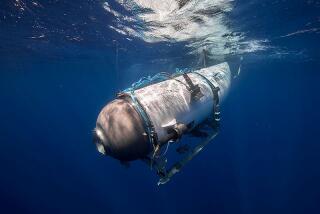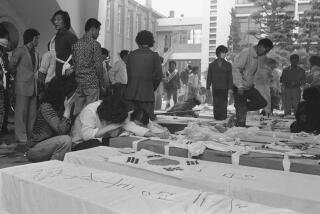Spain’s Cava Exports a Sparkling Success
- Share via
SANT SADURNI D'ANOIA, Spain — On the manicured grounds of Freixenet, the world’s biggest producer of cava sparkling wine, comes a persistent clanking, like money dropping into a cash register.
The sound is of bottling machines working full-speed, and it represents not small change but more than $300 million yearly. Worldwide sales of cava, which began 124 years ago as an alternative to champagne, are booming.
But trouble lurks in the sprawling vineyards of cava country.
Freixenet and another family-run competitor, Codorniu, are engaged in a war of charges and counter-charges so bitter that the Spanish government has told both to cool it for fear of damaging the wine’s image.
Behind the feud are allegations that corners are being cut in cava production to meet a thirsty global demand that has almost doubled since 1986 to 60.7 million bottles last year. About 12.2 million bottles were shipped to the United States.
French champagne makers, by comparison, exported 86.5 million bottles last year, a 14% increase over 1986. Of the total, 12.5 million were sent to the United States.
Dynasties dueling in this scenic wine country, lying between the Mediterranean Sea and a mountain range in northeast Spain’s Catalonia region, sounds like the stuff of soap operas.
In fact, it is.
“Saga of Power,” which began last year and is now the most-watched TV show in Catalonia, chronicles the tale of feuding cava producers.
“We could never have predicted tensions would erupt among the big cava producers in real life,” said assistant director Eduard Calvo of the show’s reality-follows-fiction twist. “We’re not that smart. But then again, we don’t touch on the real issues of tension. It would be too sensitive for us to get into.”
In the show, the cava rivals settle their differences with poison and bullets. In real life, they do it by filing complaints with the government’s Cava Regulatory Council and the courts.
Codorniu is suing Freixenet for allegedly cutting cava’s aging period in the bottle to under the minimum required nine months. Freixenet has filed a complaint with the regulatory council that Codorniu is over-irrigating its vineyards to increase yield.
Freixenet and Codorniu’s relations have become so strained that the presidents of the two companies refused to shake hands at a meeting with the regulatory council.
All this has clouded what is a remarkable success story. Sales of cava have skyrocketed because it has wide appeal--varieties range from a dry brut to semi-sweet--and because it is cheaper than champagne.
As Freixenet’s director of exports from 1975 to 1985, Manuel Duran was a major player in opening up foreign markets. Large wine vendors were familiar with champagne, made from chardonnay and pinot noir grapes. When Duran told them cava was made from xarel-lo, macabeu and parellada grapes, he got blank looks.
“They’d complain, ‘But it’s not chardonnay,’ ” recalled Duran, now a Freixenet vice president. “I’d simply pour them a glass and say, ‘Well, taste it.’ ”
Invariably, cases were ordered, and word spread. Freixenet, which exported only 300,000 bottles in 1975, shipped 43 million in 1995 to more than 100 countries.
Codorniu accounts for most of the rest of Spain’s cava exports. Company officials refused to be interviewed, citing a “pact of silence” with the Agriculture Ministry to discourage news reports on the feud.
Some smaller producers, such as Jose Puig Subirana, director of the Parxet brand, fear Freixenet and Codorniu will produce inferior wine if they try to hustle the product out too fast.
“If they cut the bottle fermentation time, or try to grow more grapes per hectare, the product will become more like this,” Subirana said, pointing at a glass of mineral water on his desk. “It will give cava a bad reputation.”
More to Read
Sign up for Essential California
The most important California stories and recommendations in your inbox every morning.
You may occasionally receive promotional content from the Los Angeles Times.








